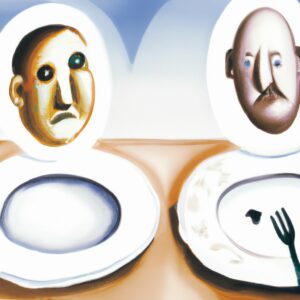Diet plays an important role in maintaining good health. One of the most common questions related to nutrition is: How many meals a day are healthy? There are many opinions on this, and sometimes they seem to contradict each other. Some experts recommend three balanced meals a day, while others say it’s better to eat several smaller meals and snacks. A growing number of people also see fasting as a way to improve their health. In this article, we’ll take a closer look at the pros and cons of fasting and snacking to find out which method works best for a healthy diet.
Fast
Effective method of weight loss and improvement of metabolism
Fasting is a method of not eating food for a certain period of time. There are several types of fasting, including intermittent fasting, where you have specific meal times, and longer periods of fasting, where you don’t eat anything for several days. A big benefit of fasting is that it can help reduce body weight and improve insulin sensitivity. For example, a 2018 study found that both intermittent and continuous calorie fasting led to significant weight loss and improvements in metabolic profile (Schübel et al., 2018). In addition, fasting may lower the risk of chronic diseases such as diabetes, cancer, and Alzheimer’s disease (Mattson et al., 2018).

Another 2018 study looked at the effects of the so-called “8-hour window” on body weight and metabolic factors in obese adults. Participants ate their meals within 8 hours of the day and fasted for the remaining 16 hours. The study found that the 8-hour window can be an effective method for weight loss and improving risk factors for metabolic diseases (Gabel et al., 2018).
Another potential positive effect of fasting is the calming of the autonomic nervous system, which may help reduce stress levels (Mattson et al., 2018).
The disadvantages of fasting
Although fasting has some health benefits, there are also some disadvantages that should be considered. Some people may experience headaches, dizziness, weakness, or nausea during fasting. It can also be difficult to get used to a new meal plan and incorporate it into everyday life. Fasting may also not be suitable for all people, especially those with certain health problems or eating disorders. It is therefore advisable to consult a doctor before starting fasting.
Popular types of fasting
- Intermittent fasting:
This method involves fasting within a certain period of time, followed by a period of eating. A popular variant is the 16:8 method, in which you fast for 16 hours and eat all meals within 8 hours. - Long-term fasting:
In this case, food is avoided for several days or even weeks. - Calorie-restricted fasting:
Here, calorie intake is reduced during fasting to promote weight loss.
Snacking
Great way to maintain energy needs and reduce hunger
Snacking refers to eating small portions of food between main meals. Snacks can be a great way to maintain energy needs throughout the day and reduce hunger between meals. A wide variety of healthy snacks are available, which are full of important nutrients such as fiber, protein, and vitamins, including fruits, vegetables, nuts, yogurt, and whole grains.
Another benefit of snacks is that they can help keep blood sugar levels stable, especially when combined with a source of protein or fiber. This can help you feel energized and focused throughout the day. Snacks can also provide an opportunity to absorb extra nutrients that you may not get in your main meals.
The disadvantages of snacking
However, there are also some disadvantages of snacking. If you’re not careful, snacks can lead to higher calorie consumption and thus weight gain. In particular, snacks rich in sugar, fat or salt can increase the risk of obesity and chronic diseases such as diabetes and heart disease. For example, a 2014 study found that higher consumption of high-calorie, low-nutrient density snacks was associated with poorer diet quality and a higher risk of cardiovascular disease (Nicklas et al., 2014).
Recommendations for healthy snacking
- Choose healthy snacks: Opt for nutrient-dense foods like fruits, vegetables, nuts, or yogurt instead of snacks high in sugar, fat, or salt.
- Pay attention to portion sizes: Snacks should be consumed in moderation to keep an eye on calorie consumption.
- Combine protein and fiber: A combination of protein and fiber can help keep blood sugar levels stable and stay full longer.
- Avoid snacks before bed: Snacks right before bed can disrupt sleep and interfere with weight loss.
Comparison of fasting and snacking
Advantages and disadvantages at a glance
In order to better compare the advantages and disadvantages of fasting and snacking, we have compared them in a table with references.
| Properties | Fast | Snacking |
|---|---|---|
| Weight | Effective for weight loss, reduces fat mass and abdominal circumference [1] | May lead to weight gain [3] |
| Heart Health | Improvement of blood pressure, cholesterol and insulin resistance [1] | Unhealthy snacks increase risk of heart disease [3] |
| Chronic diseases | Reducing the risk of diabetes, cancer and Alzheimer’s [1] | – |
| Hunger control | May help control hunger and reduce calorie intake [1] | May help reduce hunger between meals [3] |
| Nutrient density | Lower nutrient intake possible, especially with prolonged fasting [2] | May help absorb extra nutrients [3] |
| Simplicity | Easy to integrate, but can be unfamiliar at first [2] | – |
The updated table makes it clear that fasting can be an effective way to lose weight and improve heart health by lowering blood pressure, cholesterol, and insulin resistance due to reduced food consumption. It is also able to lower the risk of diabetes, cancer and Alzheimer’s. However, there is a risk of lower nutrient intake during longer periods of fasting.
Snacking can help reduce hunger between meals and absorb extra nutrients if the snacks consist of healthy foods. However, with unhealthy snacks, it can increase the risk of heart disease and lead to weight gain.
Both methods have their respective advantages and disadvantages, and it is important to make the choice between fasting and snacking based on individual needs and preferences. However, a balanced diet with nutrient-dense foods should be a priority in both cases.
Result
Ultimately, the choice between fasting and snacking depends on which method works best for a person. Both methods have advantages and disadvantages and can be part of a balanced diet. However, it is important to make sure that you get enough nutrients and that snacks are selected in moderation to ensure a balanced diet. The decision also depends on individual needs, preferences and goals.
The studies have shown that both fasting and snacking have their advantages and disadvantages. The 16:8 method of intermittent fasting may be an effective method for weight loss and improving heart health (Schübel et al., 2018). On the other hand, snacks can help maintain energy needs and reduce hunger between meals, as long as they are selected in moderation and to ensure a balanced diet.
It’s important to be aware that a balanced diet should primarily consist of nutrient-dense foods such as fruits, vegetables, whole grains, lean proteins, and healthy fats. It is advisable to pay attention to a sufficient nutrient density in the diet and to refrain from the consumption of high-sugar and high-fat snacks or at least to consume them in moderation.
References:
- Schübel, R., Nattenmüller, J., Sookthai, D., Nonnenmacher, T., Graf, M. E., Riedl, L., … & Kühn, T. (2018). Effects of intermittent and continuous calorie restriction on body weight and metabolism over 50 wk: a randomized controlled trial. The American Journal of Clinical Nutrition, 108(5), 933-945.
- Gabel, K., Hoddy, K. K., Haggerty, N., Song, J., Kroeger, C. M., Trepanowski, J. F., … & Varady, K. A. (2018). Effects of 8-hour time restricted feeding on body weight and metabolic disease risk factors in obese adults: A pilot study. Nutrition and Healthy Aging, 4(4), 345-353.
- Nicklas, T. A., O’Neil, C. E., & Fulgoni III, V. L. (2014). Snacking patterns, diet quality, and cardiovascular risk factors in adults. BMC public health, 14(1), 388.
